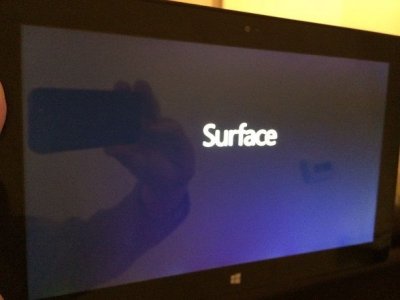Windows RT Recovery Image Here for 8.1 Upgrade Issues
By Kevin ParrishOctober 21, 2013 11:14 AM - Source: VentureBeat | B 11 comments
Tags : Windows RT r
Tablets r
Microsoft r
Windows RT 8.1 has bricked a number of devices. Here is how to fix your Windows install.
On Saturday, reports began to surface (no pun intended) that the Windows RT 8.1 update rolling out to current Microsoft customers since Thursday were bricking/disabling a number of devices. The update was pulled over the weekend, and confirmed by Microsoft. So far it's unknown how many devices have been rendered useless after the update.
"Microsoft is investigating a situation affecting a limited number of users updating their Windows RT devices to Windows RT 8.1," a company forum moderator stated on Saturday. "As a result, we have temporarily removed the Windows RT 8.1 update from the Windows Store. We are working to resolve the situation as quickly as possible and apologize for any inconvenience."
Some users are reportedly receiving a Recovery BSOD, warning device owners that Windows RT needs to be repaired. The error message states that the Boot Configuration Data file is missing some required information, and that the device owner needs to use the recovery tools in the installation media.
KickThatComputer found a temporary fix, requiring users to create a bootable USB drive, go into the command prompt, and type in "bootrec /rebuildbcd" at the C prompt. However Microsoft has released a Surface RT recovery image for Windows RT weighing in at 3.7 GB. As with the previous fix, Microsoft instructs customers to create a bootable FAT32-based USB drive, then copy the contents of the recovery image to the USB Flash drive.
What's interesting here is that Windows RT 8.1 was completed in late August, and both Microsoft and hardware vendors would have presumably spotted scenarios such as this before the update was released. Even more, the update, for now, is only provided through Windows Store, meaning customers with more than one Windows device are required to download and update each separately as opposed to downloading the updates once and distributing them via a USB drive accordingly.
Reports regarding the initial problem span Surface RT and third-party Windows RT tablets, but Microsoft's new recovery image option should work on the latter as well. So far there's no word on when Windows RT 8.1 will return to Microsoft Store. Meanwhile, below are the instructions to fix startup error 0xc000000d:
1) Download the recovery drive files.
a) Go to
http://download.microsoft.com
b) In the Search box enter Surface RT Recovery and the press Enter.
c) Tap or click on Surface RT Recovery in the search results and follow the instructions on the screen to download.
2) When the download is complete, create the Surface USB recovery drive.
a) Insert your USB drive into the USB port of your PC.
b) From the desktop, open File Explorer.
c) Tap and Hold or right-click on the USB drive and choose Format.
d) Select FAT32 as the file system and enter a Volume label to name the USB drive, such as RECOVERY, and then tap or click Start.
e) Tap or click OK to erase the contents of the USB drive.
f) Tap or click OK when the format is complete.
g) Copy the contents of the recovery image you downloaded to the USB flash drive.
Use a Surface RT USB recovery drive to fix startup error 0xc000000d
1) Turn Surface RT off by pressing the power button.
2) Start Surface RT using the USB recovery drive.
a) Insert the USB recovery drive into the USB port.
b) Press and hold the volume-down (–) rocker.
c) Press and release the power button.
d) When the Surface logo appears, release the volume rocker.
e) Surface will start the recovery software on the USB recovery drive.
3) When prompted, choose your language options and keyboard layout.
4) Tap or click Troubleshoot.
5) Tap or click Advanced Options.
6) Tap or click Command Prompt.
7) From the BitLocker screen, tap on the screen to hide the touch keyboard and then tap or click Skip This Drive at the bottom of the screen.
8) At the command prompt,
a) Type bootrec /rebuildbcd, and then press Enter.
b) When asked “Add installation to boot list? Yes (Y) No (N) All (A)” type the letter A, and then press Enter.
c) Type Exit, and then press Enter. The command prompt window will close.
9) Tap or click Continue.
10) Surface will restart and complete the Windows RT 8.1 update.
11) After the Windows RT 8.1 update is complete, sign in to Windows.
12) Swipe in from the right edge of the screen, tap Search, then enter command. In the search results, tap and hold Command Prompt, release and then tap Run as administrator. (If you’re using a keyboard, use Windows+X and then tap or click Command Prompt (Admin).)
13) At the administrator command prompt,
a) Type reagentc /enable, and then press Enter.
b) Type diskpart and then press enter.
c) At the “DISKPART>” prompt,
i) Type sel disk 0 and then press Enter.
ii) Type sel part 5 and then press Enter.
iii) Type Assign letter=R and then press Enter.
iv) Type Exit and then press Enter to exit the DISKPART command.
d) Type reagentc /setosimage /path R:\recoveryimage /index 4 and then press Enter.
e) Type Exit, and then press Enter. The command prompt window will close.
14) Remove the USB recovery drive from Surface.
15) Swipe in from the right edge of the screen, and then tap Settings. Tap or click Power, and then tap or click Restart.
Surface will restart and the Windows RT 8.1 update will be complete.

